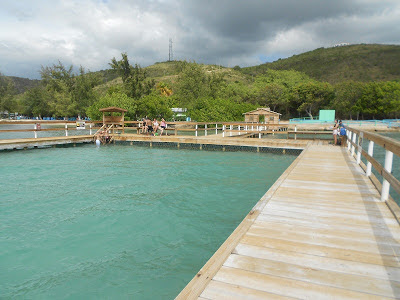One of my best friends here in Guatemala, Chris, works as a
project manager at a silver mine. For
the last year we’ve known him, he has wanted to take us out to the mine so we
can see the “other half” of his life. He
finally made it happen (for the first 3 of our friends at least) on Saturday.
As we got closer to the village where Chris lives 5 days of
the week, he asked us to lock our doors.
A lot of the locals are in opposition to the mine, for many
reasons. From what Chris told us
yesterday, a lot of their unrest is based upon ignorance. They are scared of pollution and
contamination from the mining chemicals.
What many of them probably don’t know is that Chris’s mine is one of
maybe only 5 in the world that uses a new filtration system which enables them
to use water on something of a “closed circuit”—meaning that there is no
contaminated water being discharged into local streams. Some of the locals are also against a US
company coming in and making so much money on their resources. Yet Chris explained the other side of that
too; his company employs almost 1,000 Guatemalans, and more importantly, they
train those local workers for high level positions so they gain the expertise
to undertake projects like this efficiently and safely. Furthermore, the
company pays Guatemalan taxes and the local communities receive royalties from
the silver mined. The company is also
actively re-foresting over-farmed patches of hillside and working to plant
coffee (and a portion of those profits go back to local communities). At the mine, they give free tours to local
community members and explain these things and more, and with new knowledge,
they gain more support.
Nevertheless. There’s
still a lot of resentment. We passed
multiple anti-mine signs, and Chris regaled us with stories of riots and close
calls from his first year of working in the village. (My pictures of the signs are blurry because I took them on the way home, as the sun was starting to go down, so lighting wasn't right through the moving car windows).
 |
"More than 98% say no to the chemical mining of metals.
Welcome Pacific towns in resistance." |
 |
| "Water and life are worth more than silver and gold." |
Aside from a kid throwing his orange peel at our truck,
though, we didn’t have any trouble.
We arrived at the mine, and Chris showed us to his office
where we suited up (in rubber boots, a belt containing a self-rescuer in case
of fire and a battery for our head lamps, a hardhat, head lamp, reflective
vests, and safety glasses) and listened to a safety talk before going
underground.
 |
| Helping each other get ready...those belts are tricky. |
 |
| Ready to go underground! |
I’m not sure what I pictured the mining process to be. I had a vague notion that I would not find
men with pick axes chipping the shiny stuff out of the walls. But beyond that? I hadn’t even tried to imagine how it would
be done. So at the end of the day when
Chris asked us what we’d learned, I kept wishing “everything” was an
appropriate answer.
Chris started by showing us maps of the mine—first 2D views
of the mine both horizontally and looking down vertically, and then a 3D
version on his computer, complete with projections of development in the next 5
years.
 |
| 2D maps of the mine |
The mine is designed with long main ramps that slope down,
and coming off them are little fingers of earth called stopes. So in order to mine the silver, they dig a
tunnel at the top and bottom of the stope, then drill small holes from the top (60ft
deep) in which they put explosives. They
blow up the entire stope, reducing it to a pile of loose rock within the
mountain. Then a truck goes in at the
bottom tunnel of the stope and loads up the loose rock, taking it to the
surface to be processed.
The rock then goes through a mill which reduces it from
gravel-sized to a fine, baby powder consistency.
(The mill is a giant rotating tube with heavy metal balls in
it. The tube rotates at the perfect
speed so that the balls ride halfway up, then drop from the top, crushing the
rock below them…over and over and over again).
From there, the fine powder is mixed with chemicals and
water. The chemicals make the metals
stick to air bubbles. So the most
concentrated silver floats immediately, and the bubbles are skimmed off the top
of the water. They then travel through
several vats and immediately into the concentrate room.
(Couldn't get a great picture of that, sorry. The vat
was through a grate right below my feet.)
For the stuff that doesn’t immediately float, a bit more
chemicals are mixed in, and that makes the lead (and the silver sticking to the
lead) float, and then that is skimmed
off and goes to concentrate.
 |
| Skimming off the lead bubbles |
If it doesn’t float there, chemicals are added which
neutralize the old chemicals and make the zinc (and the silver sticking to it)
float, and the same process is followed.
It’s all a really cool process, and it was an intensely
interesting day. It was also fun to
drive around the mine with Chris pointing out, “That was my project. I designed that. I contracted that building. I did all the calculations to make that work. None of these buildings were here when I got
here.” Definitely an experience I never
dreamed of, but one I’m very glad I had!
 |
| Up on the hill looking down at the whole mining operation. |

























Comments
Post a Comment